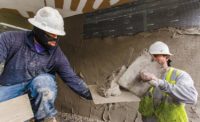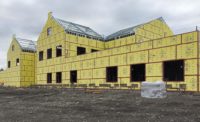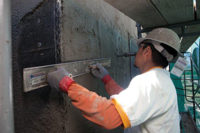Stucco Stop
Cold Weather Application




The undeniable fact about applying stucco and EIFS is that it happens outside. It would be great if the outside gave us perfect weather, 70 degrees Fahrenheit, sunshine and a gentle breeze. If you are a plasterer in temperate climate zones, such as Hawaii, Southern California or Phoenix in the winter, you will find these conditions. The truth is plasters, like mailmen, must carry on through rain, sleet, hail and snow. Winter is upon us and we still need to get the job done.
Understanding how stucco and EIFS dry and/or cure can help one to be successful when plastering in the cold temperatures. One must also recognize the documented guidelines and temperature ranges that are stated in our codes and standards, and those set by product manufacturers (see inset).
There are two temperature metrics that effect our applications; Ambient, the temperature of the air around us and Surface, the temperature of the building surface or materials being used. We recognize that there are times when the temperature envelope gets pushed but it is when there is a total disregard to the temperatures or even a little “temperature ignorance” that the real issues arise.
Stucco Hydration
Portland cement stucco cures to its final hardness through a process known as hydration and applies to all of the cement layers; scratch, brown and finish. During hydration, the cement particles absorb the water used in mixing and begin a chemical process in which “connectors” grow to bond the particles together (inset, Figure 1). These microscopic connectors are little crystals that grow as the water evaporates, and bind the cement particles together.
In the cold, below 40 degrees F, evaporation ceases and the water just stays in place. This is not necessarily an issue unless the water freezes or the stucco is disturbed. If the water in the mix freezes it will expand, don’t forget the connectors aren’t growing, and when it thaws and evaporates, leaves larger voids between the particles. These voids then don’t allow the cement particles to bond close enough and thus compromise the strength.
|
Side Job
ASTM C-926-12a 12. Environmental Conditions 12.1—Portland cement-based plaster shall not be applied to frozen base or to a base containing frost. Plaster mixes shall not contain frozen ingredients. Plaster coats shall be protected from freezing for a period of not less than 24 hours after set has occurred. 12.3.2—For exteriors, plaster shall be applied when the ambient temperature is higher than 40 degrees F (4.4 degrees C), unless the work area is enclosed and heat is provided. |
Severely frozen stucco, evidenced by ice crystal fossils left behind, just crumbles when disturbed and should be removed and replaced. If the water doesn’t freeze but just stays cold and below 40 degrees F, the surface of the stucco could be damaged by impact or building movement before it is cured. No evaporation, no hydration, not the best scenario for connectors to grow and lock together.
Cement is unique in that the particles can continue to grow the connectors, when additional water is added (hydrated), until they reach their full absorption potential. This may in fact be later than 24 hours depending on the climactic conditions. If the stucco didn’t freeze, it is possible to continue the hydration process the next day after the stucco has hardened, to complete the hydration process and have a good stucco cladding. Usually in these conditions the stucco is hard to the touch and cannot be manipulated (troweled or floated).
EIFS Hydration Process
EIFS cement basecoats also reach final curing and hardening through the hydration process but are also enhanced by an acrylic kicker. This is a more sophisticated process where Portland cement is added to a polymer mixture to form an acrylic modified basecoat. Not only are connectors grown (the cement) but polymer chains are formed (the polymer basecoat mixture) to make a durable and flexible weather barrier coat. Polymer chains rely on the evaporation of water in the mix to fully form. Once the mixture is applied to the wall, the water begins to evaporate and the polymers begin to bind (Figure 2). After about 24 hours the polymers bind into what is known as a polymer chain.
Just like Portland cement, if the water freezes in the basecoat the same results can be expected. Unlike cement, if the water freezes in the basecoat, the polymers will not form the chain and durability becomes permanently compromised. Once the water has left the polymer one cannot just add more to continue the process. Once it’s gone, it’s done.
Methods For Cold Weather Application
So what can be done to apply stucco and EIFS in cold weather? One of the most common methods is to enclose the workspace and apply heat. This process is referred to as tenting and heating and is a process of wrapping tarps or plastic on the outside of the scaffolding and over onto the roof surface placing the working surface in a “tent.” Then heat is applied most commonly in the form of gas heaters to maintain temperatures in compliance with the codes, standards and manufacturers specifications.
Propane heaters are the most common form of fuel-fired heaters used on job sites. The actual heating units can be moved to distribute the heat where needed. Of course extreme caution should be used when heaters are present. Obviously you don’t want to catch anything on fire, but you should also consider having good ventilation in the tented area, so as not to asphyxiate the workers. One of the byproducts of burning propane is moisture, so as you are adding heat you are also adding moisture. Another thing to remember is that heat rises, so the top of the wall areas will most likely dry first. And even though it is more comfortable, you don’t need to have it nice and toasty, just above 40 degrees F for a 24-hour period. The 24-hour period is important, so make sure there is enough fuel to keep the heaters going. Never use kerosene heaters because they give off petroleum based soot that gets into the acrylic products and can damage them.
Stucco and EIFS have been applied successfully in the cold weather for many years. Keeping a close eye on the temperature conditions, not pushing the envelope too far and understanding that the production rates may suffer a bit will contribute to long lasting, performance-as-intended stucco or EIFS cladding. Keep warm my friends.
Looking for a reprint of this article?
From high-res PDFs to custom plaques, order your copy today!







